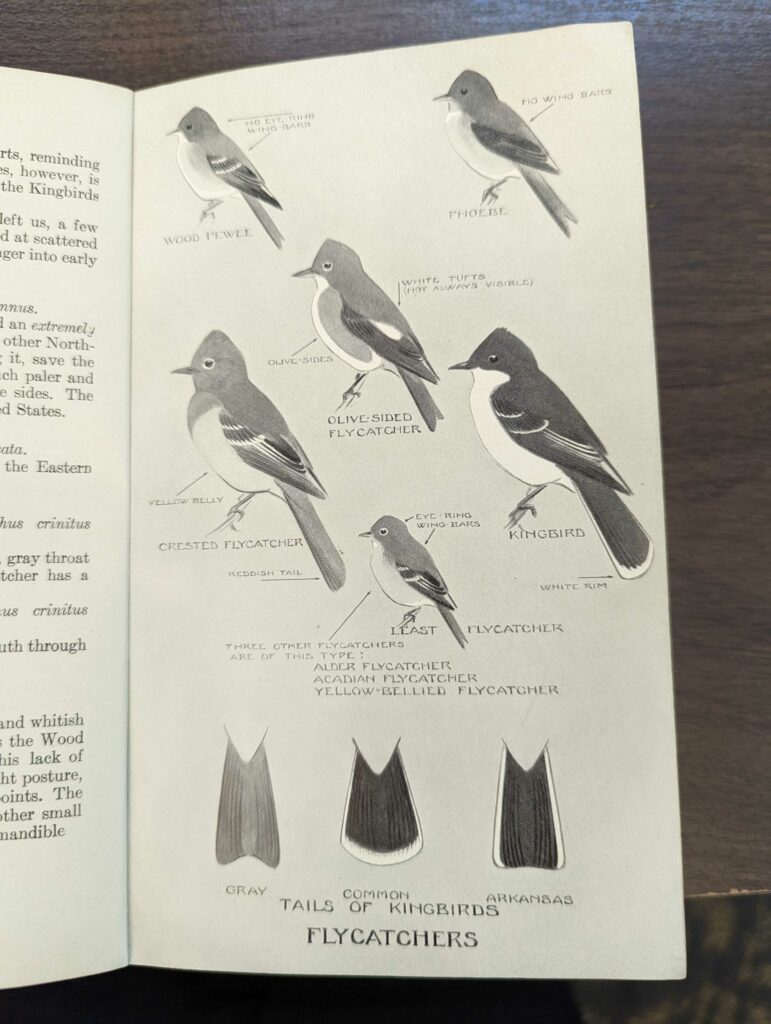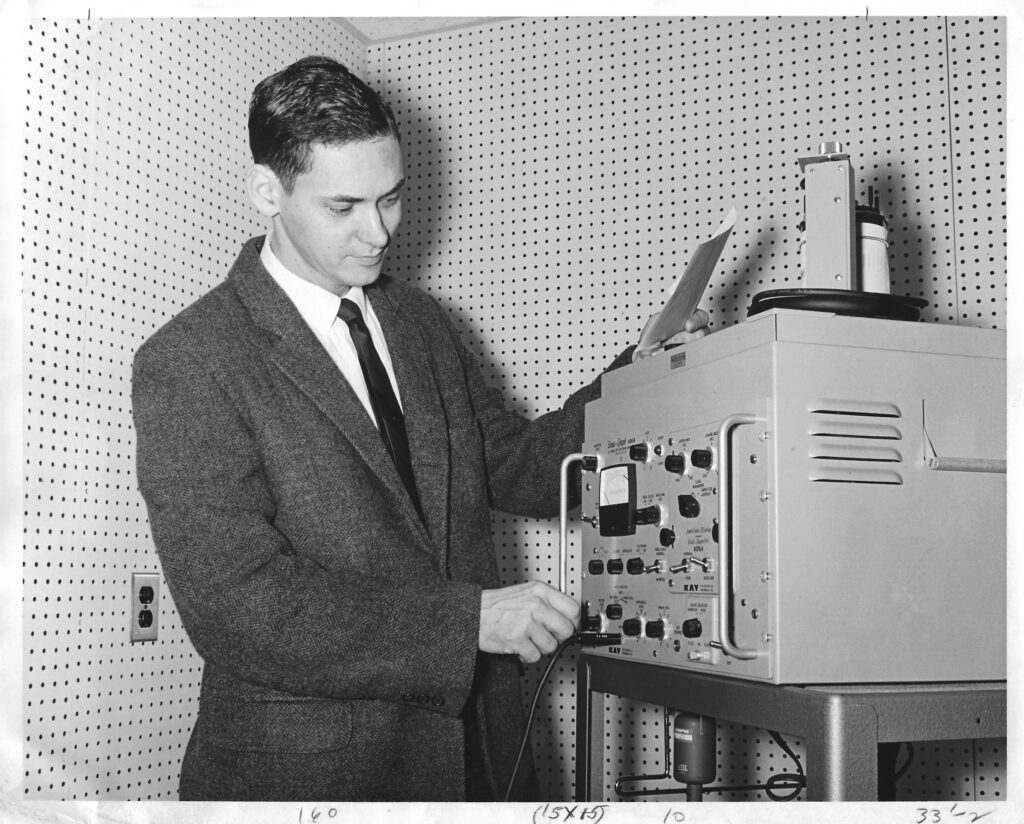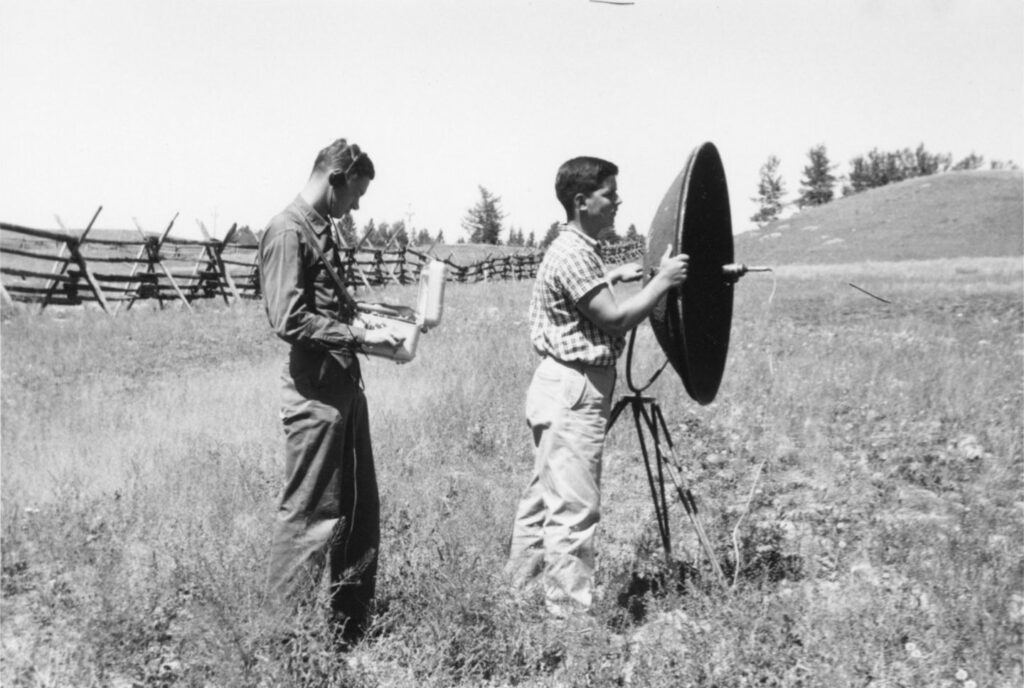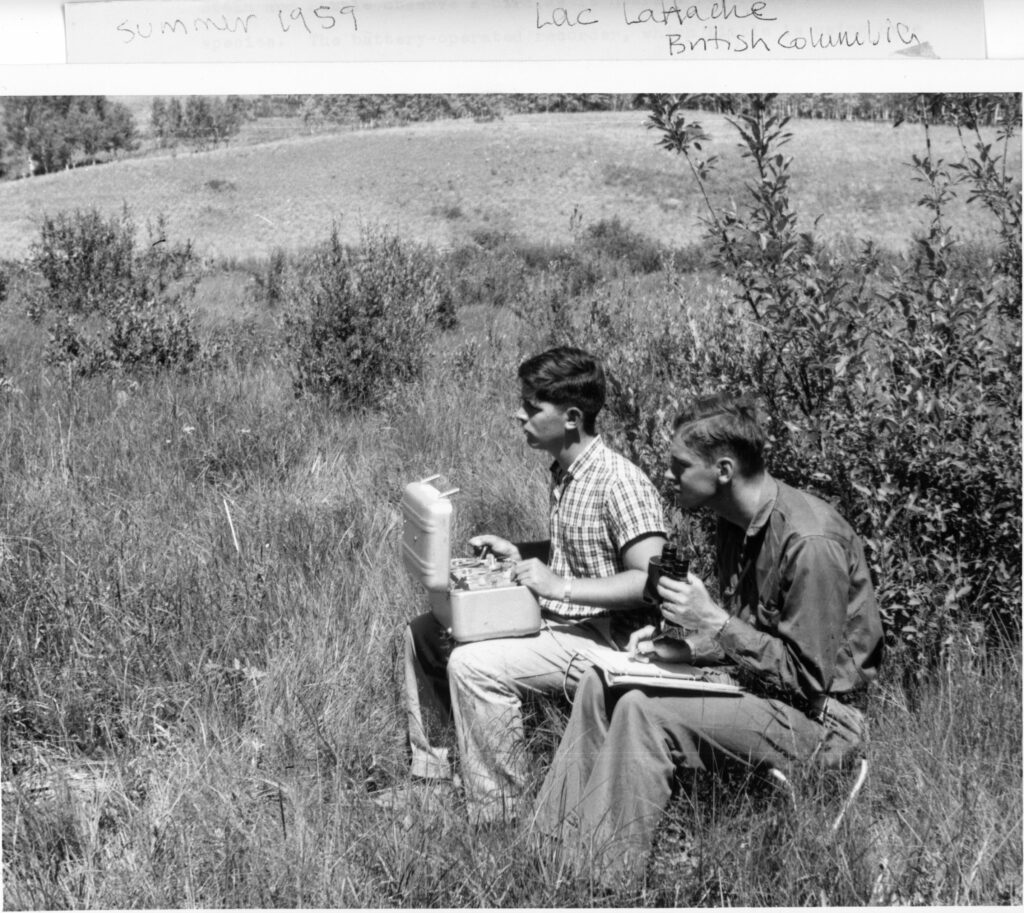We’ve all seen a flycatcher or, let’s be honest, five that left us puzzled…was that an Alder Flycatcher or a Willow Flycatcher? If only that flycatcher would have uttered a few notes, then we’d have a chance at figuring out which species we spotted.
We have Robert C. Stein to thank for his pioneering work on the vocal differences in “Traill’s Flycatcher” that now helps us separate Alder and Willow Flycatchers.
In the early days of ornithology, species identification relied heavily on physical characteristics, with very little consideration of voice. Physical characteristics were measurable and the golden standard for scientific research. As for bird sounds, “at the time,” says Stein, “[bird song] was all anecdotal.” Bird song was to be enjoyed by the senses. And recording bird sounds was a hobby of amateur ornithologists.
Ornithologists made note of species that sang different songs, but the prevailing view at the time was that differences were a local phenomenon. For example, Roger Tory Peterson published A Field Guide to the Birds: Giving Field Marks of all Species Found in Eastern North America in 1934 where he pointed out vocal differences in the Alder Flycatcher (Empidonax traillii traillii Note: Peterson referred to the species as Alder, see sidebar below). Peterson writes, “a glance at the voice description of this species in our standard works will show a great variety of interpretation. One thing is certain—the bird utters quite a different call in Ohio than it does in New York and eastward.” Peterson ends the account with “possibly collection would prove that other differences existed.”

[Sidebar: John James Audubon first described the Alder/Willow Flycatcher to science in 1828, which he called Muscicapa traillii after his friend Dr. Thomas Stewart Traill of Edinburgh based on a specimen taken in Arkansas. Muscicapa traillii back then was commonly referred to as the Alder Flycatcher, but was later called the Traill’s Flycatcher, resulting in much confusion. As noted by James Sedgwick (2020) in the Willow Flycatcher species account in Birds of the World, “some authors accept Empidonax traillii (Audubon 1828) as the proper name for the Alder Flycatcher and use the name Empidonax brewsteri (Oberholser 1918) for the Willow Flycatcher.” It appears that Audubon’s specimen (Muscicapa traillii) could have been a migrating Alder Flycatcher, not a Willow Flycatcher as one would presume based on the scientific name ascribed in later years.]
Today we are well aware that physical differences between the flycatchers are few (especially when seen in the field) and the real difference lies in their vocalizations as Stein described in his manuscript published in 1963. But it would take a few more years for the scientific community to understand the power of bird vocalizations, a facet which we now take for granted when ascribing species status.
Although Arthur Allen, Peter Paul Kellogg, Albert Brand, and others at the Cornell Lab of Ornithology started recording bird sounds as early as 1929, the technology was rudimentary and the recording equipment was very bulky. Recording equipment was also difficult to find as parabolic technologies were limited to military use during World War II. In the early days of recording, they also did not have a standard way of measuring sounds other than by verbal descriptions, which limited the scientific credibility.
It wasn’t until 1951 when two technologies emerged that changed the face of sound recording, systematics, and bioacoustics. In 1951 Peter Paul Kellogg, an engineer and ornithologist at Cornell, and his colleagues invented the Magnemite recorder, the first portable recording device. In the same year, the Kay Electric Company produced a Vibralyzer or a Sona-graph as it later became known that created a visual representation of sound. One of the first uses of a spectrogram for bird studies was by Kellogg and Stein in 1953. The first sona-graphs went through many iterations as technologies advanced, becoming the modern day spectrogram that is an essential part of vocal studies.

As luck would have it, Stein was in the right place at the right time. Stein came to Cornell under the tutelage of Arthur Allen (AKA Doc) in 1952, right when sound technologies were taking off. Even though Doc retired a year later, Stein found great mentorship under Kellogg, the engineer who really made things happen to advance the field. “Kellogg had the tools to solve the problem,” Stein said.
While young Stein sought out research questions for his Masters, he proposed to Doc that he could research the cryptic Empidonax flycatchers. Doc cautioned Stein that all the flycatchers would be too much to tackle. Stein, lacking funding, needed to keep his field work local so Doc suggested that Stein tackle what Peterson and others noticed about vocal variation in Traill’s Flycatchers. Fortuitously for Stein, both of the vocal variations of Traill’s Flycatchers occurred around Ithaca. “So I looked at the song types which had been confused in the literature and nobody had been able to resolve,” said Stein.
Stein then got to work building his committee and designing his research project. Another fortuitous encounter came when Stein met Robert T. Clausen, professor of Botany at Cornell. Clausen, who Stein says “was a real stickler for accuracy,” taught him a lot about the scientific method. Stein relates Clausen’s advice with eager conviction; “the key,” says Stein, “is that you have to ask the right question and then think about how to design an experiment to test your hypothesis.” Clausen encouraged Stein to think about the question from the right perspective. The question wasn’t about how humans could tell the difference between the flycatchers, but how the flycatchers themselves could tell the difference.
Stein set out to do field work around the Great Lakes where he made hundreds of recordings to study song variation. But because measurements of bird sounds were still in their infancy, Stein reported the differences he observed descriptively: a fitz-bew type and a fee-be-o type. Stein says back then “they would not let me call it a separate species,” because that was the state of bioacoustics research then. Any differences in voice were often deemed a local phenomenon.
Determined to prove that what he found around the Great Lakes was not just a local phenomenon, Stein expanded his research for his PhD, this time under the tutelage of Kellogg. Stein mounted two expeditions across the U.S. and into British Columbia, one in 1958 with Martin Michener as his field assistant and one in 1959 with Randy Little as his assistant.

Stein was one of the first ornithologists to use spectrograms to demonstrate measurable differences in voice that are important isolating factors and a means of species recognition. Stein was also among the first to use playback to assess each species’ behavioral response when hearing the songs and calls of different species after being inspired by Konrad Lorenz. Stein even made a papier-mâché model of a flycatcher that he placed near the speaker to examine how each species responded. Today playback and vocal analyses are so commonly used that we don’t even think twice about them.

Stein’s work across the U.S. and British Columbia culminated in the publication of his seminal work in 1963 that clearly made the case that the Traill’s Flycatcher was two separate species. Stein demonstrated that the two vocal types showed clear and consistent differences as shown in spectrograms. His research also identified behavioral differences in response to playback of the different vocal types, differences in nesting ecology, and morphological differences in specimens. But it wasn’t until 1973 that the American Ornithologists’ Union (now the American Ornithological Society) officially declared them separate species: the Alder (Empidonax alnorum), and Willow (Empidonax traillii) Flycatcher. Stein says, “all of this kind of stuff, in any other field except bird sound would have been accepted pretty easily, but bird song was for popular non-scientific hobbies,” so it took 10 years for the work to be accepted.
Stein was a leader in the field, but to this day he is as humble as ever. “The thing that has impressed me more,” says Stein, “and that I’ve been more conscious over the last couple of weeks, is that the study has had as much influence as it has historically, because it was all a matter of circumstance and, you know, being at the right place at the right time, getting the right advice, and asking the right questions. I look back and it’s quite classic in its approach, I mean it’s not really an avant-garde kind of thing other than it’s based on sound rather than all the sort of classic studies that one would look at.”
Stein’s contribution to ornithology didn’t stop there. According to science historian Joeri Bruyninckx, in his book Listening in the Field – Recording and the Science of Birdsong, Kellogg and Stein submitted an application to the National Science Foundation in 1962 in which “they argued not only that the planned library (then the Library of Natural Sounds that is now the Macaulay Library) would be crucial to Cornell’s own ethological investigations, but that it would offer long-term intellectual benefits to the study of systematic and ecological problems more generally. Recorded sounds functioned in ‘parallel to morphological specimens,’ but also had other advantages: they provided ‘documentary material about behavioral sequences’ and enabled documentation of “the ontogeny of individual sound patterns.” (Bruyninckx 2018). It was the pioneering work of many people, including Stein that laid the foundation for moving beyond the physical specimen to include behavior and sound in systematics.
After Cornell, Stein went on to teach biology and ornithology at Buffalo State University (now part of SUNY Buffalo) from 1965-1996. At Buffalo State, Stein passed along the advice of Kellogg, Doc, and Clausen to his students and encouraged them to aim high. “Sure, you’re going to fail some of the time, but sometimes you make it. Aspire to something, which you think is beyond what you can do,” said Stein. Stein also told his students, “you have to make observations before you can ask intelligent questions. Then it’s about asking the right questions.”
Stein continued his work on bird sounds studying crows in Australia and pipits at the Max Planck Institute. But over the years, Stein’s hearing started to deteriorate making it difficult for him to record and study bird sounds. Forever the learner, Stein shifted his attention to new pursuits such as stamp collecting and philosophy.
Stein recently returned to Ithaca and was determined to find and listen to his flycatchers again. Jay McGowan, an archival coordinator at the Macaulay Library, took Stein and his daughter Misty and son-in-law Mark Nodine out in the field and made his dreams come true. Still spry at 90 with keen eyes, Stein was quick to point out good habitat, urging McGowan to stop. McGowan put a large pair of headphones on Stein’s head, turned up the volume, and pointed a parabola at a Willow Flycatcher. “The look on Dad’s face when he heard the flycatchers,” says Misty Nodine, Stein’s daughter, “was priceless.”

Thank you Bob Stein for your contributions to ornithology! Stein’s 2,066 recordings are available to listen to in the Macaulay Library. Take a listen and step back through time.

Kellogg, P. P., and R. C. Stein. (1953). Audio-spectrographic analysis of the songs of the Alder Flycatcher. The Wilson Bulletin 65: 75-80.
Stein, R. C. (1963). Isolating mechanisms between populations of Traill’s Flycatchers. Proceedings of the American Philosophical Society 107: 21–50.




